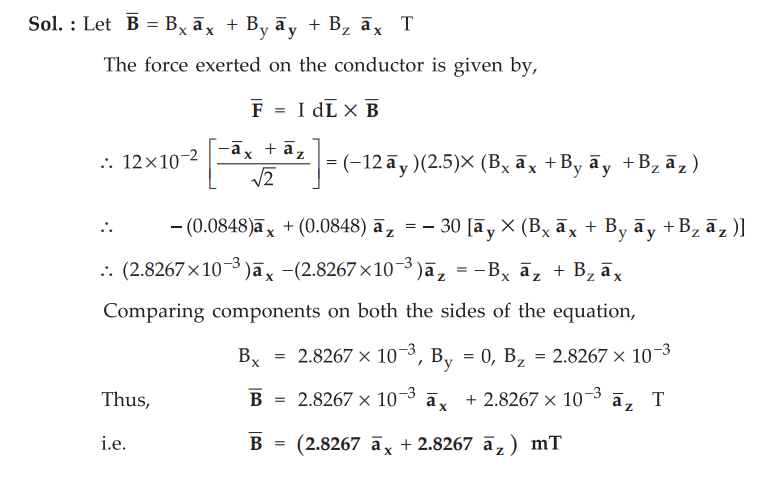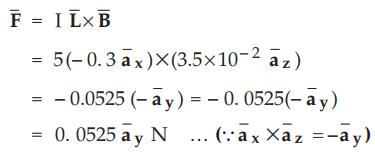Electromagnetic Theory: Unit III: (b) Magnetic Forces, Magnetic Materials and Inductance
Force on a Differential Current Element
Statement, Proof, Equation, Solved Example Problems
• Practically a differential element of charge is made up of very large number of small and discrete charges. The volume thus occupied by these charge is obviously small but it is effectively greater than the average separation between charges.
Force on a Differential Current Element
•
Practically a differential element of charge is made up of very large number of
small and discrete charges. The volume thus occupied by these charge is
obviously small but it is effectively greater than the average separation
between charges. The differential force given by equation (8.3.1) is the
addition of the forces on the individual charges.
•
Consider a conductor in which the electrons are in motion. Along with these
electrons in motion, the immobile positive ions form a crystalline array
structure of a conductor with the magnetic field applied to the conductor, a
force is exerted on the electrons and thus their position is slightly shifted.
Hence a small displacement is produced between the centers of gravity of
positive and negative charges. But this displacement is opposed by Coulomb's
forces between positive ions and electrons. So when electrons try to move, the
force of attraction between electrons and positive ions is observed. Thus the
magnetic force gets transferred to the conductor itself. In good conductor, the
Coulomb's forces are much greater than magnetic forces. Thus the separation of
charges is observed which indicates that small potential difference exists
across conductor in a direction perpendicular to the magnetic field as velocity
of charges both. The small voltage across conductor is called Hall voltage and the
effect is called Hall effect.
•
The concept of Hall effect is used to measure the magnetic flux density. In
some applications, the current through device is made proportional to the
magnetic field, then the device based on Hall effect can be used as electronic
wattmeter and squaring elements. Another application of the Hall effect is
observed in the semiconductor physics. In semiconductors, the equal current is
provided by holes which are positively charged as well as electrons which are
negatively charged. The Hall effect is useful in determining whether the given
semiconductor material is p-type or n-type as the Hall voltages for both the
materials are different.

•
But the differential element of charge can be expressed in terms of the volume
charge density as,
dQ
= ρv dv ... (8.3.3)
•
Substituting value of dQ in equation (8.3.1),

•
But we have already studied in previous chapter, the relationship between
current element as,

•
Then the force exerted on a surface current density is given by,

•
Similarly the force exerted on a differential current element is given by,

•
Integrating equation (8.3.4) over a volume, the force is given by,

•
Integrating equation (8.3.5) over either open or closed surface, we get,

•
Similarly integrating equation (8.3.6) over a closed path, we get,

•
Note that the magnetic field developed by current element to I ![]() does not exert a force on the element itself similar to a point charge does not
exert a force in itself. In other words, the magnetic field
does not exert a force on the element itself similar to a point charge does not
exert a force in itself. In other words, the magnetic field ![]() is always
external to the current element I
is always
external to the current element I ![]() .
.
•
If a conductor is straight and the field B is uniform along it, then
integrating equation (8.3.6) we get simple expression for the force as,

The
magnitude of the force is given by,
F
= I L B sin θ
•
Actually the magnetic field exerts a magnetic force on the electrons which
constitutes the current I. But these electrons are part of the conductor, this
magnetic force gets transferred to the conductor lattice. Now this transferred
force can perform work on a conductor as a whole.
Ex.
8.3.1 A conductor 6 m long, lies along z-direction with a current of 2 A in ![]() direction. Find the force experienced by conductor if
direction. Find the force experienced by conductor if  .
.
Sol.
:
A force exerted on current carrying conductor in a magnetic field is given by,

Ex.
8.3.2 A conductor of length 2.5 m in z = 0 and x = 4 m carries a current of 12
A in - ![]() direction. Calculate the uniform flux density in the
region, if the force on the conductor is 12 × 10-2 N in the direction
specified by
direction. Calculate the uniform flux density in the
region, if the force on the conductor is 12 × 10-2 N in the direction
specified by 
Sol.
:

Ex.
8.3.3 A magnetic field  exerts a force on a 0.3 m long conductor
along x axis. If a current of 5 A flows in
exerts a force on a 0.3 m long conductor
along x axis. If a current of 5 A flows in ![]() direction, determine
what force must be applied to hold conductor in position.
direction, determine
what force must be applied to hold conductor in position.
Sol.
:
The force exerted on a straight conductor is given by,

Hence
the force applied to hold the conductor in position must be

Examples
for Practice
Ex.
8.3.4 A current strip 2 cm wide carries a
current of 15 A in ![]() direction, as shown in the Fig. 8.3.1. Find
the force on the strip of unit length if the uniform field is
direction, as shown in the Fig. 8.3.1. Find
the force on the strip of unit length if the uniform field is  tesla.
tesla.

Ex. 8.3.5
A current element 4 cm long is along y-axis with a current of 10 mA flowing in
y-direction. Determine the force on the current element due to the magnetic
field, if the magnetic field H = [5 ax / µ] A/m.

Ex.
8.3.6 A conductor 4 m long lies along the
y-axis with a current of 10 A in the ![]() direction. Find the force on
the conductor if the field in the region is
direction. Find the force on
the conductor if the field in the region is  Tesla.
Tesla.

Review Questions
1. Derive various expressions for force on a differential
current element.
2. Write a note on force on a differential current element.
Electromagnetic Theory: Unit III: (b) Magnetic Forces, Magnetic Materials and Inductance : Tag: : Statement, Proof, Equation, Solved Example Problems - Force on a Differential Current Element
Related Topics
Related Subjects
Electromagnetic Theory
EE3301 3rd Semester EEE Dept | 2021 Regulation | 3rd Semester EEE Dept 2021 Regulation
